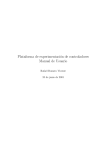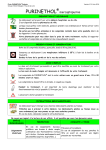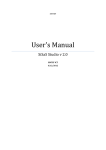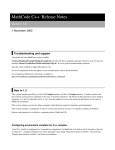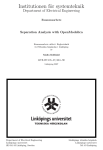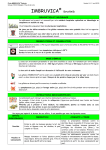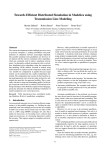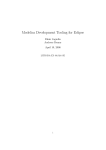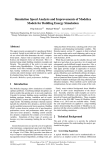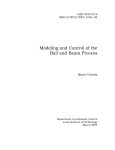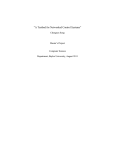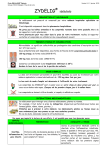Download Introduction to Object-Oriented Modeling, Simulation and
Transcript
Introduction to Object-Oriented Modeling, Simulation and Control with Modelica Tutorial, February 2012, at MODPROD by Peter Fritzson Linköping University, [email protected] Olena Rogovchenko Linköping University, [email protected] Slides Based on book and lecture notes by Peter Fritzson Contributions 2004-2005 by Emma Larsdotter Nilsson, Peter Bunus Contributions 2006-2008 by Adrian Pop and Peter Fritzson Contributions 2009 by David Broman, Peter Fritzson, Jan Brugård, and Mohsen Torabzadeh-Tari Contributions 2010 by Peter Fritzson Contributions 2011 by Peter F., Mohsen T,. Adeel Asghar 2012-02-07 Tutorial Based on Book, 2004 Download OpenModelica Software Peter Fritzson Principles of Object Oriented Modeling and Simulation with Modelica 2.1 Wiley-IEEE Press, 2004, 940 pages • OpenModelica • www.openmodelica.org • Modelica Association • www.modelica.org 2 Copyright © Open Source Modelica Consortium 1 New Introductory Modelica Book September 2011 232 pages Wiley IEEE Press For Introductory Short Courses on Object Oriented Mathematical Modeling 3 Copyright © Open Source Modelica Consortium Acknowledgements, Usage, Copyrights • If you want to use the Powerpoint version of these slides in your own course, send an email to: [email protected] • Thanks to Emma Larsdotter Nilsson, Peter Bunus, David Broman, Jan Brugård, Mohsen-Torabzadeh-Tari, Adeel Asghar for contributions to these slides. • Most examples and figures in this tutorial are adapted with permission from Peter Fritzson’s book ”Principles of Object Oriented Modeling and Simulation with Modelica 2.1”, copyright Wiley-IEEE Press • Some examples and figures reproduced with permission from Modelica Association, Martin Otter, Hilding Elmqvist, and MathCore • Modelica Association: www.modelica.org • OpenModelica: www.openmodelica.org 4 Copyright © Open Source Modelica Consortium 2 Outline Part I Introduction to Modelica and a demo example Part III Modelica language concepts and textual modeling 5 Part II Modelica environments Part IV Graphical modeling and the Modelica standard library Copyright © Open Source Modelica Consortium Detailed Schedule 09:00 - Introduction to Modeling and Simulation • Start installation of OpenModelica including OMEdit graphic editor 09:10 - Modelica – The Next Generation Modeling Language 09:25 - Exercises Part I (15 minutes) • Short hands-on exercise on graphical modeling using OMEdit– RL Circuit 09:50 – Part II: Modelica Environments and the OpenModelica Environment 10:10 – Part III: Modelica Textual Modeling 10:15 - Exercises Part IIIa (30 minutes) • Hands-on exercises on textual modeling using the OpenModelica environment 10:45 – Coffee Break 11:00 - Modelica Discrete Events and Hybrid Properties 11:15 - Exercises Part IIIb (10 minutes) • Hands-on exercises on textual modeling using the OpenModelica environment 11:25 – Part IV: Components, Connectors and Connections - Modelica Libraries 11:45 - Graphical Modeling using OpenModelica 12:00 - Exercises Part IV (30 minutes) – DCMotor etc. • 6 Hands-on exercises on graphical modeling using OpenModelica Copyright © Open Source Modelica Consortium 3 Software Installation - Windows • Start the software installation • Install OpenModelica-1.8.0.msi from the USB Stick 7 Copyright © Open Source Modelica Consortium Software Installation – Linux (requires internet connection) • Go to https://openmodelica.org/index.php/download/down load-linux and follow the instructions. 8 Copyright © Open Source Modelica Consortium 4 Software Installation – MAC (requires internet connection) • Go to https://openmodelica.org/index.php/download/down load-mac and follow the instructions or follow the instructions written below. • The installation uses MacPorts. After setting up a MacPorts installation, run the following commands on the terminal (as root): • echo rsync://build.openmodelica.org/macports/ >> /opt/local/etc/macports/sources.conf # assuming you installed into /opt/local • port selfupdate • port install openmodelica-devel 9 Copyright © Open Source Modelica Consortium Part I Introduction to Modelica and a demo example 10 Copyright © Open Source Modelica Consortium 5 Modelica Background: Stored Knowledge Model knowledge is stored in books and human minds which computers cannot access “The change of motion is proportional to the motive force impressed “ – Newton 11 Copyright © Open Source Modelica Consortium Modelica Background: The Form – Equations • Equations were used in the third millennium B.C. • Equality sign was introduced by Robert Recorde in 1557 Newton still wrote text (Principia, vol. 1, 1686) “The change of motion is proportional to the motive force impressed ” CSSL (1967) introduced a special form of “equation”: variable = expression v = INTEG(F)/m Programming languages usually do not allow equations! 12 Copyright © Open Source Modelica Consortium 6 What is Modelica? A language for modeling of complex physical systems • • • • • • 13 Robotics Automotive Aircrafts Satellites Power plants Systems biology Copyright © Open Source Modelica Consortium What is Modelica? A language for modeling of complex physical systems Primary designed for simulation, but there are also other usages of models, e.g. optimization. 14 Copyright © Open Source Modelica Consortium 7 What is Modelica? A language for modeling of complex physical systems i.e., Modelica is not a tool Free, open language specification: There exist several free and commercial tools, for example: • OpenModelica from OSMC • MathModelica by MathCore • Dymola by Dassault systems / Dynasim • SimulationX by ITI • MapleSim by MapleSoft Available at: www.modelica.org 15 Copyright © Open Source Modelica Consortium Modelica – The Next Generation Modeling Language Declarative language Equations and mathematical functions allow acausal modeling, high level specification, increased correctness Multi-domain modeling Combine electrical, mechanical, thermodynamic, hydraulic, biological, control, event, real-time, etc... Everything is a class Strongly typed object-oriented language with a general class concept, Java & MATLAB-like syntax Visual component programming Hierarchical system architecture capabilities Efficient, non-proprietary Efficiency comparable to C; advanced equation compilation, e.g. 300 000 equations, ~150 000 lines on standard PC 16 Copyright © Open Source Modelica Consortium 8 Modelica Acausal Modeling What is acausal modeling/design? Why does it increase reuse? The acausality makes Modelica library classes more reusable than traditional classes containing assignment statements where the input-output causality is fixed. Example: a resistor equation: R*i = v; can be used in three ways: i := v/R; v := R*i; R := v/i; 17 Copyright © Open Source Modelica Consortium What is Special about Modelica? • Multi-Domain Modeling • Visual acausal hierarchical component modeling • Typed declarative equation-based textual language • Hybrid modeling and simulation 18 Copyright © Open Source Modelica Consortium 9 What is Special about Modelica? Multi-Domain Modeling 19 Copyright © Open Source Modelica Consortium What is Special about Modelica? Multi-Domain Modeling Keeps the physical structure Visual Acausal Hierarchical Component Modeling Acausal model (Modelica) Causal block-based model (Simulink) 20 Copyright © Open Source Modelica Consortium 10 What is Special about Modelica? Hierarchical system modeling Multi-Domain Modeling k2 i qddRef qdRef qRef 1 1 S S k1 axis6 cut joint r3Control tn r3Drive1 r3Motor i Visual Acausal Hierarchical Component Modeling 1 qd axis5 l qdRef Kd S rel 0.03 Jmotor=J pSum Kv sum w Sum +1 - 0.3 +1 - joint=0 rate3 b(s) 340.8 a(s) S axis4 S iRef rate2 gear=i fric=Rv0 qRef spring=c axis3 tacho2 b(s) b(s) a(s) a(s) tacho1 g5 PT1 axis2 qd C=0.004*D/w m Rd1=100 Rp1=200 axis1 Vs Srel = n*transpose(n)+(identity(3)n*transpose(n))*cos(q)Rd2=100 Ri=10 skew(n)*sin(q); + + wrela = n*qd; + diff pow er OpI zrela = n*qdd; Sb = Sa*transpose(Srel); Rd4=100 r0b = r0a; vb = Srel*va; g3 wb = Srel*(wa + wrela); g1 ab = Srel*aa; zb = Srel*(za + zrela + cross(wa, wrela)); Ra=250 La=(250/(2*D*w m)) q Rp2=50 rate1 Rd3=100 emf hall2 hall1 y x inertial w r Courtesy of Martin Otter g2 21 qd g4 q Copyright © Open Source Modelica Consortium What is Special about Modelica? Visual Acausal Hierarchical A textual class-based language Component OO primary used for as a structuring concept Modeling Behaviour described declaratively using • Differential algebraic equations (DAE) (continuous-time) • Event triggers (discrete-time) Multi-Domain Modeling Variable declarations Typed Declarative Equation-based Textual Language 22 class VanDerPol "Van der Pol oscillator model" Real x(start = 1) "Descriptive string for x”; Real y(start = 1) "y coordinate”; parameter Real lambda = 0.3; equation der(x) = y; der(y) = -x + lambda*(1 - x*x)*y; end VanDerPol; Differential equations Copyright © Open Source Modelica Consortium 11 What is Special about Modelica? Multi-Domain Modeling Visual Acausal Component Modeling Hybrid modeling = continuous-time + discrete-time modeling Continuous-time Discrete-time Typed Declarative Equation-based Textual Language 23 time Hybrid Modeling Copyright © Open Source Modelica Consortium Modelica – Faster Development, Lower Maintenance than with Traditional Tools Block Diagram (e.g. Simulink, ...) or Proprietary Code (e.g. Ada, Fortran, C,...) vs Modelica Systems Definition Modeling of Subsystems System Decomposition Causality Derivation (manual derivation of input/output relations) Implementation Simulation Proprietary Code Block Diagram Modelica 24 Copyright © Open Source Modelica Consortium 12 Modelica vs Simulink Block Oriented Modeling Simple Electrical Model Modelica: Physical model – easy to understand Keeps the physical structure Simulink: Signal-flow model – hard to understand Res2 p p R2 R1=10 sum3 -1 1 Ind 1/L l2 1 s R2=100 sum2 p n +1 n +1 AC=220 p p n sinln sum1 +1 -1 C=0.01 Res1 1/R1 Cap 1/C l1 1 s L=0.1 n n p G 25 Copyright © Open Source Modelica Consortium Graphical Modeling - Using Drag and Drop Composition 26 Copyright © Open Source Modelica Consortium 13 Multi-Domain (Electro-Mechanical) Modelica Model • A DC motor can be thought of as an electrical circuit which also contains an electromechanical component model DCMotor Resistor R(R=100); Inductor L(L=100); VsourceDC DC(f=10); Ground G; ElectroMechanicalElement EM(k=10,J=10, b=2); Inertia load; equation R L connect(DC.p,R.n); connect(R.p,L.n); DC connect(L.p, EM.n); connect(EM.p, DC.n); connect(DC.n,G.p); connect(EM.flange,load.flange); G end DCMotor 27 EM load Copyright © Open Source Modelica Consortium Corresponding DCMotor Model Equations The following equations are automatically derived from the Modelica model: (load component not included) Automatic transformation to ODE or DAE for simulation: 28 Copyright © Open Source Modelica Consortium 14 Model Translation Process to Hybrid DAE to Code Modelica Graphical Editor Modelica Model Modelica Textual Editor Modelica Source code Modelica Model Translator Frontend Modeling Environment Flat model Hybrid DAE Analyzer "Middle-end" Sorted equations Optimizer Backend Optimized sorted equations Code generator C Code C Compiler Executable Simulation 29 Copyright © Open Source Modelica Consortium Modelica in Power Generation GTX Gas Turbine Power Cutoff Mechanism Hello Courtesy of Siemens Industrial Turbomachinery AB 30 Developed by MathCore for Siemens Copyright © Open Source Modelica Consortium 15 Modelica in Automotive Industry 31 Copyright © Open Source Modelica Consortium Modelica in Avionics 32 Copyright © Open Source Modelica Consortium 16 Modelica in Biomechanics 33 Copyright © Open Source Modelica Consortium Application of Modelica in Robotics Models Real-time Training Simulator for Flight, Driving • Using Modelica models generating real-time code • Different simulation environments (e.g. Flight, Car Driving, Helicopter) • Developed at DLR Munich, Germany • Dymola Modelica tool Courtesy of Martin Otter, DLR, Oberphaffenhofen, Germany 34 Copyright © Open Source Modelica Consortium 17 Brief Modelica History • First Modelica design group meeting in fall 1996 • International group of people with expert knowledge in both language design and physical modeling • Industry and academia • Modelica Versions • • • • • • • 1.0 released September 1997 2.0 released March 2002 2.2 released March 2005 3.0 released September 2007 3.1 released May 2009 3.2 released March 2010 3.3 expected May 2012 • Modelica Association established 2000 in Linköping • Open, non-profit organization 35 Copyright © Open Source Modelica Consortium Modelica Conferences • The 1st International Modelica conference October, 2000 • The 2nd International Modelica conference March 18-19, 2002 • The 3rd International Modelica conference November 5-6, 2003 in Linköping, Sweden • The 4th International Modelica conference March 6-7, 2005 in Hamburg, Germany • The 5th International Modelica conference September 4-5, 2006 in Vienna, Austria • The 6th International Modelica conference March 3-4, 2008 in Bielefeld, Germany • The 7th International Modelica conference Sept 21-22, 2009 in Como, Italy • The 8th International Modelica conference March 20-22, 2011 in Dresden, Germany • Coming: The 9th International Modelica conference Sept 3-5, 2012 in Munich, Germany 36 Copyright © Open Source Modelica Consortium 18 Exercises Part I Hands-on graphical modeling (15 minutes) 37 Copyright © Open Source Modelica Consortium Exercises Part I – Basic Graphical Modeling • • • • (See instructions on next two pages) Start the OMEdit editor (part of OpenModelica) Draw the RLCircuit Simulate R1 L R=10 R=100 L=1 L=0.1 A C The RLCircuit Simulation G 38 Copyright © Open Source Modelica Consortium 19 Exercises Part I – OMEdit Instructions (Part I) • Start OMEdit from the Program menu under OpenModelica • Go to File menu and choose New, and then select Model. • E.g. write RLCircuit as the model name. • For more information on how to use OMEdit, go to Help and choose User Manual or press F1. • Under the Modelica Library: • Contains The standard Modelica library components • The Modelica files contains the list of models you have created. 39 Copyright © Open Source Modelica Consortium Exercises Part I – OMEdit Instructions (Part II) • For the RLCircuit model, browse the Modelica standard library and add the following component models: • Add Ground, Inductor and Resistor component models from Modelica.Electrical.Analog.Basic package. • Add SineVolagte component model from Modelica.Electrical.Analog.Sources package. • Make the corresponding connections between the component models as shown in slide 37. • Simulate the model • Go to Simulation menu and choose simulate or click on the siumulate button in the toolbar. • Plot the instance variables • 40 Once the simulation is completed, a plot variables list will appear on the right side. Select the variable that you want to plot. Copyright © Open Source Modelica Consortium 20 Part II Modelica environments and OpenModelica 41 Copyright © Open Source Modelica Consortium Dymola • • • • • 42 Dynasim (Dassault Systemes) Sweden First Modelica tool on the market Main focus on automotive industry www.dynasim.com Copyright © Open Source Modelica Consortium 21 Simulation X 43 • • • • ITI Germany Mechatronic systems www.simulationx.com • • • Maplesoft Canada Recent Modelica tool on the market Integrated with Maple www.maplesoft.com Copyright © Open Source Modelica Consortium MapleSim • • 44 Copyright © Open Source Modelica Consortium 22 MathModelica – MathCore / Wolfram Research • • • • • • Wolfram Research USA, Sweden General purpose Mathematica integration www.wolfram.com www.mathcore.com Mathematica Courtesy Wolfram Research 45 Car model graphical view Simulation and analysis Copyright © Open Source Modelica Consortium The OpenModelica Environment www.OpenModelica.org 46 Copyright © Open Source Modelica Consortium 23 OpenModelica (Part I) • • • • • OpenModelica Open Source Modelica Consortium (OSMC) Sweden and other countries Open source www.openmodelica.org • • 47 OMEdit, graphical editor OMOptim, optimization subsystem Copyright © Open Source Modelica Consortium OpenModelica (Part II) • Advanced Interactive Modelica compiler (OMC) • Supports most of the Modelica Language • Basic environment for creating models • • • 48 OMShell – an interactive command handler OMNotebook – a literate programming notebook MDT – an advanced textual environment in Eclipse Copyright © Open Source Modelica Consortium • ModelicaML UML Profile • MetaModelica extension • ParModelica extension 48 24 OSMC – Open Source Modelica Consortium 40 organizational members February 2012 Founded Dec 4, 2007 Open-source community services • • • • • Website and Support Forum Version-controlled source base Bug database Development courses www.openmodelica.org Code Statistics 49 Copyright © Open Source Modelica Consortium OSMC 40 Organizational Members, Feb 2012 (initially 7 members, 2007) Companies and Institutes (22 members) Universities (18 members) • • • • • • • • • • • • • • • • • • • • • • 50 ABB Corporate Research, Sweden Bosch Rexroth AG, Germany Siemens PLM, California, USA Siemens Turbo Machinery AB, Sweden CDAC Centre for Advanced Computing, Kerala, India Creative Connections, Prague, Czech Republic DHI, Aarhus, Denmark Evonik, Dehli, India Equa Simulation AB, Sweden Fraunhofer FIRST, Berlin, Germany Frontway AB, Sweden IFP, Paris, France InterCAX, Atlanta, USA ISID Dentsu, Tokyo, Japan MathCore Engineering/ Wolfram, Sweden Maplesoft, Canada TLK Thermo, Germany Sozhou Tongyuan Software and Control, China VI-grade, Italy VTI, Linköping, Sweden VTT, Finland XRG Simulation, Germany • • • • • • • • • • • • • • • • • • Linköping University, Sweden TU Berlin, Institute of UEBB, Germany FH Bielefeld, Bielefeld, Germany TU Braunschweig, Institute of Thermodynamics, Germany TU Dortmund, Proc. Dynamics, Germany Technical University Dresden, Germany Université Laval, modelEAU, Canada Georgia Institute of Technology, USA Ghent University, Belgium Griffith University, Australia Hamburg Univ. Technology/TuTech, Institute of Thermo-Fluid, Germany University of Ljubljana, Slovenia University of Maryland, Inst. Systems Engineering, USA University of Maryland, CEEE, USA Politecnico di Milano, Italy Ecoles des Mines, ParisTech, CEP, France Mälardalen University, Sweden Telemark University College, Norway Copyright © Open Source Modelica Consortium 25 OMNotebook Electronic Notebook with DrModelica • • • Primarily for teaching Interactive electronic book Platform independent Commands: • Shift-return (evaluates a cell) • File Menu (open, close, etc.) • Text Cursor (vertical), Cell cursor (horizontal) • Cell types: text cells & executable code cells • Copy, paste, group cells • Copy, paste, group text • Command Completion (shifttab) 51 Copyright © Open Source Modelica Consortium OMnotebook Interactive Electronic Notebook Here Used for Teaching Control Theory 52 Copyright © Open Source Modelica Consortium 26 OpenModelica MDT – Eclipse Plugin • Browsing of packages, classes, functions • Automatic building of executables; separate compilation • Syntax highlighting • Code completion, Code query support for developers • Automatic Indentation • Debugger (Prel. version for algorithmic subset) 53 Copyright © Open Source Modelica Consortium OpenModelica MDT: Code Outline and Hovering Info Identifier Info on Hovering Code Outline for 54 easy navigation within Modelica files Copyright © Open Source Modelica Consortium 54 27 The OpenModelica MDT Debugger (Eclipse-based) Using Japanese Characters 55 Copyright © Open Source Modelica Consortium Interactive Simulation with OpenModelica Examples of Simulation Visualization Simulation Control Plot View Requirements Evaluation View in ModelicaML MaxLevel Liquid Source Level h Level h Tank 1 56 Domain-Specific Visualization View Tank 2 Copyright © Open Source Modelica Consortium 28 OMOptim – Optimization (1) Model structure 57 Model Variables Copyright © Open Source Modelica Consortium Problems OMOptim – Optimization (2) Solved problems 58 Optimized parameters Optimized Objectives Result plot Export result data .csv Copyright © Open Source Modelica Consortium 29 General Tool Interoperability & Model Exchange Functional Mock-up Interface (FMI) The FMI development is part of the MODELISAR 29-partner project • • • • • FMI development initiated by Daimler Improved Software/Model/Hardware-in-the-Loop Simulation, of physical models and of AUTOSAR controller models from different vendors for automotive applications with different levels of detail. Open Standard 14 automotive use cases for evaluation > 10 tool vendors are supporting it etc. Engine with ECU Gearbox with ECU Thermal systems Automated cargo door Chassis components, roadway, ECU (e.g. ESP) functional mockup interface for model exchange and tool coupling courtesy Daimler 59 Copyright © Open Source Modelica Consortium OPENPROD – Large 28-partner European Project, 2009-2012 Vision of Cyber-Physical Model-Based Product Development Feedback Business Process Control Requirements Capture Model-Driven Design (PIM) Compilation & Code Gen (PSM) System Simulation Software & Syst Product Process models Requirements models Product models Platform models Unified Modeling: Meta -modeling& Modelica& UML & OWL OPENPROD Vision of unified modeling framework for model-driven product development from platform independent models (PIM) to platform specific models (PSM) Current work based on Eclipse, UML/SysML, OpenModelica 60 Copyright © Open Source Modelica Consortium 30 OpenModelica – ModelicaML UML Profile SysML/UML to Modelica OMG Standardization • ModelicaML is a UML Profile for SW/HW modeling • Applicable to “pure” UML or to other UML profiles, e.g. SysML • Standardized Mapping UML/SysML to Modelica • Defines transformation/mapping for executable models • Being standardized by OMG • ModelicaML • Defines graphical concrete syntax (graphical notation for diagram) for representing Modelica constructs integrated with UML • Includes graphical formalisms (e.g. State Machines, Activities, Requirements) • Which do not exist in Modelica language • Which are translated into executable Modelica code • Is defined towards generation of executable Modelica code • Current implementation based on the Papyrus UML tool + OpenModelica 61 Copyright © Open Source Modelica Consortium Example: Simulation and Requirements Evaluation Req. 001 is instantiated 2 times (there are 2 tanks in the system) tank-height is 0.6m Req. 001 for the tank2 is violated Req. 001 for the tank1 is not violated 62 Copyright © Open Source Modelica Consortium 31 OpenModelica – Recent Developments and Plans • January 2012. OpenModelica 1.8.1 release with operator overloading, faster compilation, ModelicaML with valuebindings • 2012. Continued high priority on better support for the Modelica standard library. • Spring 2012. Support for larger models and improved simulation. • February 2012. Shifting to bootstrapped OpenModelica compiler for development. • March 2011. Subset Fluid library flattening and simulating • March 2012. Thermopower library simulating • March 2011. Further improved support for MultiBody simulation. • April 2011. Most of Fluid library flattening • April-May 2011. Most of Media and Fluid libraries simulating • May-June 2012. Integrated Modelica debugger. 63 Copyright © Open Source Modelica Consortium Part III Modelica language concepts and textual modeling Typed Declarative Equation-based Textual Language 64 Hybrid Modeling Copyright © Open Source Modelica Consortium 32 Acausal Modeling The order of computations is not decided at modeling time Acausal Causal Visual Component Level Equation Level 65 A resistor equation: R*i = v; Causal possibilities: i := v/R; v := R*i; R := v/i; Copyright © Open Source Modelica Consortium Typical Simulation Process 66 Copyright © Open Source Modelica Consortium 33 Simple model - Hello World! Equation: x’ = - x Initial condition: x(0) = 1 Name of model Initial condition model HelloWorld "A simple equation" Real x(start=1); parameter Real a = -1; equation der(x)= a*x; end HelloWorld; Continuous-time variable Parameter, constant during simulation Simulation in OpenModelica environment Differential equation 1 0.8 simulate(HelloWorld, stopTime = 2) plot(x) 0.6 0.4 0.2 0.5 67 1 1.5 2 Copyright © Open Source Modelica Consortium Modelica Variables and Constants • Built-in primitive data types Boolean true or false Integer Integer value, e.g. 42 or –3 Real Floating point value, e.g. 2.4e-6 String String, e.g. “Hello world” Enumeration Enumeration literal e.g. ShirtSize.Medium • Parameters are constant during simulation • Two types of constants in Modelica • constant • parameter 68 constant constant constant parameter Real String Integer Real PI=3.141592653589793; redcolor = "red"; one = 1; mass = 22.5; Copyright © Open Source Modelica Consortium 34 A Simple Rocket Model apollo13 thrust altitude velocity velocity acceleration mg new model parameters (changeable before the simulation) floating point type differentiation with regards to time 69 thrust mass gravity mass mass massLossRate abs thrust acceleration Rocket class Rocket "rocket class" parameter String name; Real mass(start=1038.358); Real altitude(start= 59404); Real velocity(start= -2003); Real acceleration; Real thrust; // Thrust force on rocket Real gravity; // Gravity forcefield parameter Real massLossRate=0.000277; equation (thrust-mass*gravity)/mass = acceleration; der(mass) = -massLossRate * abs(thrust); der(altitude) = velocity; der(velocity) = acceleration; end Rocket; declaration comment start value name + default value mathematical equation (acausal) Copyright © Open Source Modelica Consortium Celestial Body Class A class declaration creates a type name in Modelica class CelestialBody constant Real parameter Real parameter String parameter Real end CelestialBody; g = 6.672e-11; radius; name; mass; An instance of the class can be declared by prefixing the type name to a variable name ... CelestialBody moon; ... The declaration states that moon is a variable containing an object of type CelestialBody 70 Copyright © Open Source Modelica Consortium 35 Moon Landing Rocket apollo13 thrust apollo . gravity mg altitude CelestialBody only access inside the class access by dot notation outside the class 71 moon . g moon .mass apollo .altitude moon .radius 2 class MoonLanding parameter Real force1 = 36350; parameter Real force2 = 1308; protected parameter Real thrustEndTime = 210; parameter Real thrustDecreaseTime = 43.2; public Rocket apollo(name="apollo13"); CelestialBody moon(name="moon",mass=7.382e22,radius=1.738e6); equation apollo.thrust = if (time < thrustDecreaseTime) then force1 else if (time < thrustEndTime) then force2 else 0; apollo.gravity=moon.g*moon.mass/(apollo.altitude+moon.radius)^2; end MoonLanding; Copyright © Open Source Modelica Consortium Simulation of Moon Landing simulate(MoonLanding, stopTime=230) plot(apollo.altitude, xrange={0,208}) plot(apollo.velocity, xrange={0,208}) 30000 50 100 150 200 25000 -100 20000 -200 15000 10000 -300 5000 -400 50 100 150 200 It starts at an altitude of 59404 (not shown in the diagram) at time zero, gradually reducing it until touchdown at the lunar surface when the altitude is zero 72 The rocket initially has a high negative velocity when approaching the lunar surface. This is reduced to zero at touchdown, giving a smooth landing Copyright © Open Source Modelica Consortium 36 Specialized Class Keywords • Classes can also be declared with other keywords, e.g.: model, record, block, connector, function, ... • Classes declared with such keywords have specialized properties • Restrictions and enhancements apply to contents of specialized classes • After Modelica 3.0 the class keyword means the same as model • Example: (Modelica 2.2). A model is a class that cannot be used as a connector class • Example: A record is a class that only contains data, with no equations • Example: A block is a class with fixed input-output causality model CelestialBody constant Real parameter Real parameter String parameter Real end CelestialBody; 73 g = 6.672e-11; radius; name; mass; Copyright © Open Source Modelica Consortium Modelica Functions • Modelica Functions can be viewed as a specialized class with some restrictions and extensions • A function can be called with arguments, and is instantiated dynamically when called function sum input Real arg1; input Real arg2; output Real result; algorithm result := arg1+arg2; end sum; 74 Copyright © Open Source Modelica Consortium 37 Function Call – Example Function with for-loop Example Modelica function call: ... p = polynomialEvaluator({1,2,3,4},21) function PolynomialEvaluator input Real A[:]; // array, size defined // at function call time input Real x := 1.0;// default value 1.0 for x output Real sum; protected Real xpower; // local variable xpower algorithm sum := 0; xpower := 1; for i in 1:size(A,1) loop sum := sum + A[i]*xpower; xpower := xpower*x; end for; end PolynomialEvaluator; 75 {1,2,3,4} becomes the value of the coefficient vector A, and 21 becomes the value of the formal parameter x. The function PolynomialEvaluator computes the value of a polynomial given two arguments: a coefficient vector A and a value of x. Copyright © Open Source Modelica Consortium Inheritance parent class to Color restricted kind of class without equations child class or subclass keyword denoting inheritance record ColorData parameter Real red = 0.2; parameter Real blue = 0.6; Real green; end ColorData; class Color extends ColorData; equation red + blue + green = 1; end Color; class ExpandedColor parameter Real red=0.2; parameter Real blue=0.6; Real green; equation red + blue + green = 1; end ExpandedColor; Data and behavior: field declarations, equations, and certain other contents are copied into the subclass 76 Copyright © Open Source Modelica Consortium 38 Multiple Inheritance Multiple Inheritance is fine – inheriting both geometry and color class Color parameter Real red=0.2; parameter Real blue=0.6; Real green; equation red + blue + green = 1; end Color; class Point Real x; Real y,z; end Point; multiple inheritance class ColoredPointWithoutInheritance Real x; Real y, z; parameter Real red = 0.2; parameter Real blue = 0.6; Real green; equation red + blue + green = 1; end ColoredPointWithoutInheritance; 77 class ColoredPoint extends Point; extends Color; end ColoredPoint; Equivalent to Copyright © Open Source Modelica Consortium Multiple Inheritance cont’ Only one copy of multiply inherited class Point is kept class Point Real x; Real y; end Point; class VerticalLine extends Point; Real vlength; end VerticalLine; Diamond Inheritance class HorizontalLine extends Point; Real hlength; end HorizontalLine; class Rectangle extends VerticalLine; extends HorizontalLine; end Rectangle; 78 Copyright © Open Source Modelica Consortium 39 Simple Class Definition • Simple Class Definition • Shorthand Case of Inheritance • Example: • Often used for introducing new names of types: class SameColor = Color; type Resistor = Real; Equivalent to: connector MyPin = Pin; inheritance 79 class SameColor extends Color; end SameColor; Copyright © Open Source Modelica Consortium Inheritance Through Modification • Modification is a concise way of combining inheritance with declaration of classes or instances • A modifier modifies a declaration equation in the inherited class • Example: The class Real is inherited, modified with a different start value equation, and instantiated as an altitude variable: ... Real altitude(start= 59404); ... 80 Copyright © Open Source Modelica Consortium 40 The Moon Landing - Example Using Inheritance (I) Rocket apollo13 thrust mg altitude CelestialBody model Body "generic body" Real mass; String name; end Body; model CelestialBody extends Body; constant Real g = 6.672e-11; parameter Real radius; end CelestialBody; 81 model Rocket "generic rocket class" extends Body; parameter Real massLossRate=0.000277; Real altitude(start= 59404); Real velocity(start= -2003); Real acceleration; Real thrust; Real gravity; equation thrust-mass*gravity= mass*acceleration; der(mass)= -massLossRate*abs(thrust); der(altitude)= velocity; der(velocity)= acceleration; end Rocket; Copyright © Open Source Modelica Consortium The Moon Landing - Example using Inheritance (II) inherited parameters model MoonLanding parameter Real force1 = 36350; parameter Real force2 = 1308; parameter Real thrustEndTime = 210; parameter Real thrustDecreaseTime = 43.2; Rocket apollo(name="apollo13", mass(start=1038.358) ); CelestialBody moon(mass=7.382e22,radius=1.738e6,name="moon"); equation apollo.thrust = if (time<thrustDecreaseTime) then force1 else if (time<thrustEndTime) then force2 else 0; apollo.gravity =moon.g*moon.mass/(apollo.altitude+moon.radius)^2; end Landing; 82 Copyright © Open Source Modelica Consortium 41 Inheritance of Protected Elements If an extends-clause is preceded by the protected keyword, all inherited elements from the superclass become protected elements of the subclass class Point Real x; Real y,z; end Point; class Color Real red; Real blue; Real green; equation red + blue + green = 1; end Color; Equivalent to The inherited fields from Point keep their protection status since that extends-clause is preceded by public A protected element cannot be accessed via dot notation! 83 class ColoredPoint protected extends Color; public extends Point; end ColoredPoint; class ColoredPointWithoutInheritance Real x; Real y,z; protected Real red; protected Real blue; protected Real green; equation red + blue + green = 1; end ColoredPointWithoutInheritance; Copyright © Open Source Modelica Consortium Exercises Part II (30 minutes) 84 Copyright © Open Source Modelica Consortium 42 Exercises Part II • Start OMNotebook (part of OpenModelica) • Start->Programs->OpenModelica->OMNotebook • Open File: Exercises-ModelicaTutorial.onb from the directory you copied your tutorial files to. • Note: The DrModelica electronic book has been automatically opened when you started OMNotebook. • Open Exercises-ModelicaTutorial.pdf (also available in printed handouts) 85 Copyright © Open Source Modelica Consortium Exercises 2.1 and 2.2 (See also next two pages) • Open the Exercises-ModelicaTutorial.onb found in the Tutorial directory you copied at installation. • Exercise 2.1. Simulate and plot the HelloWorld example. Do a slight change in the model, re-simulate and re-plot. Try command-completion, val( ), etc. class HelloWorld "A simple equation" Real x(start=1); simulate(HelloWorld, stopTime = 2) equation plot(x) der(x)= -x; end HelloWorld; • Locate the VanDerPol model in DrModelica (link from Section 2.1), using OMNotebook! • Exercise 2.2: Simulate and plot VanDerPol. Do a slight change in the model, re-simulate and re-plot. 86 Copyright © Open Source Modelica Consortium 43 Exercise 2.1 – Hello World! A Modelica “Hello World” model Equation: x’ = - x Initial condition: x(0) = 1 class HelloWorld "A simple equation” parameter Real a=-1; Real x(start=1); equation der(x)= a*x; end HelloWorld; Simulation in OpenModelica environment 1 simulate(HelloWorld, stopTime = 2) plot(x) 0.8 0.6 0.4 0.2 0.5 87 1 1.5 2 Copyright © Open Source Modelica Consortium Exercise 2.2 – Van der Pol Oscillator class VanDerPol "Van der Pol oscillator model" Real x(start = 1) "Descriptive string for x"; // Real y(start = 1) "y coordinate"; // parameter Real lambda = 0.3; equation der(x) = y; // This is the der(y) = -x + lambda*(1 - x*x)*y; /* This is the end VanDerPol; x starts at 1 y starts at 1 1st diff equation // 2nd diff equation */ 2 simulate(VanDerPol,stopTime = 25) plotParametric(x,y) 1 -2 -1 1 2 -1 -2 88 Copyright © Open Source Modelica Consortium 44 Exercise 2.3 – DAE Example Include algebraic equation Algebraic equations contain no derivatives Exercise: Locate in DrModelica. Simulate and plot. Change the model, simulate+plot. class DAEexample Real x(start=0.9); Real y; equation der(y)+(1+0.5*sin(y))*der(x) = sin(time); x - y = exp(-0.9*x)*cos(y); end DAEexample; Simulation in OpenModelica environment 1.20 simulate(DAEexample, stopTime = 1) plot(x) 1.15 1.10 1.05 time 1.0 0.2 0.4 0.6 0.8 1 0.95 0.90 89 Copyright © Open Source Modelica Consortium Exercise 2.4 – Model the system below • Model this Simple System of Equations in Modelica 90 Copyright © Open Source Modelica Consortium 45 Exercise 2.5 – Functions • a) Write a function, sum2, which calculates the sum of Real numbers, for a vector of arbitrary size. • b) Write a function, average, which calculates the average of Real numbers, in a vector of arbitrary size. The function average should make use of a function call to sum2. 91 Copyright © Open Source Modelica Consortium Discrete Events and Hybrid Systems Picture: Courtesy Hilding Elmqvist 92 Copyright © Open Source Modelica Consortium 46 Hybrid Modeling Hybrid modeling = continuous-time + discrete-time modeling Continuous-time Real x; Voltage v; Current i; Discrete-time discrete Real x; Integer i; Boolean b; time Events • • • • 93 A point in time that is instantaneous, i.e., has zero duration An event condition so that the event can take place A set of variables that are associated with the event Some behavior associated with the event, e.g. conditional equations that become active or are deactivated at the event Copyright © Open Source Modelica Consortium Event creation – if if-equations, if-statements, and if-expressions if <condition> then <equations> elseif <condition> then <equations> else <equations> end if; 94 model Diode "Ideal diode" extends TwoPin; Real s; Boolean off; equation off = s < 0; if off then v=s else v=0; end if; i = if off then 0 else s; end Diode; False if s<0 If-equation choosing equation for v If-expression Copyright © Open Source Modelica Consortium 47 Event creation – when when-equations when <conditions> then <equations> end when; event 1 event 2 time event 3 Equations only active at event times Time event State event when time >= 10.0 then ... end when; when sin(x) > 0.5 then ... end when; Only dependent on time, can be scheduled in advance 95 Related to a state. Check for zero-crossing Copyright © Open Source Modelica Consortium Generating Repeated Events The call sample(t0,d) returns true and triggers events at times t0+i*d, where i=0,1, … sample(t0,d) true false time t0 t0+d t0+2d t0+3d t0+4d Variables need to be discrete model SamplingClock Integer i; discrete Real r; equation when sample(2,0.5) then i = pre(i)+1; r = pre(r)+0.3; end when; end SamplingClock; 96 Creates an event after 2 s, then each 0.5 s pre(...) takes the previous value before the event. Copyright © Open Source Modelica Consortium 48 Reinit - discontinuous changes The value of a continuous-time state variable can be instantaneously changed by a reinit-equation within a when-equation model BouncingBall "the bouncing ball model" parameter Real g=9.81; //gravitational acc. parameter Real c=0.90; //elasticity constant Real height(start=10),velocity(start=0); equation der(height) = velocity; der(velocity)=-g; when height<0 then reinit(velocity, -c*velocity); end when; end BouncingBall; Initial conditions Reinit ”assigns” continuous-time variable velocity a new value 97 Copyright © Open Source Modelica Consortium Exercise 2.6 – BouncingBall • Locate the BouncingBall model in one of the hybrid modeling sections of DrModelica (the WhenEquations link in Section 2.9), run it, change it slightly, and re-run it. 98 Copyright © Open Source Modelica Consortium 49 Part IV Components, Connectors and Connections – Modelica Libraries and Graphical Modeling 99 Copyright © Open Source Modelica Consortium Software Component Model Acausal coupling Interface Connector Component Connection Component Causal coupling A component class should be defined independently of the environment, very essential for reusability A component may internally consist of other components, i.e. hierarchical modeling Complex systems usually consist of large numbers of connected components 100 Copyright © Open Source Modelica Consortium 50 Connectors and Connector Classes Connectors are instances of connector classes electrical connector connector class keyword flow indicates that currents of connected pins sum to zero. connector Pin Voltage flow Current end Pin; v; i; v + pin i Pin pin; an instance pin of class Pin mechanical connector connector class connector Flange Position s; flow Force f; end Flange; s flange f an instance flange of class Flange 101 Flange flange; Copyright © Open Source Modelica Consortium The flow prefix Two kinds of variables in connectors: • Non-flow variables potential or energy level • Flow variables represent some kind of flow Coupling • Equality coupling, for non-flow variables • Sum-to-zero coupling, for flow variables The value of a flow variable is positive when the current or the flow is into the component v pin positive flow direction: i 102 + Copyright © Open Source Modelica Consortium 51 Physical Connector • Classes Based on Energy Flow Domain Type Potential Flow Carrier Modelica Library Electrical Voltage Current Charge Electrical. Analog Position Force Linear momentum Mechanical. Translational Rotational Angle Torque Angular momentum Mechanical. Rotational Magnetic Magnetic potential Magnetic flux rate Magnetic flux Hydraulic Pressure Volume flow Volume HyLibLight Heat Temperature Heat flow Heat HeatFlow1D Chemical Chemical potential Particle flow Particles Under construction Pneumatic Pressure Mass flow Air PneuLibLight Translational 103 Copyright © Open Source Modelica Consortium connect-equations Connections between connectors are realized as equations in Modelica connect(connector1,connector2) The two arguments of a connect-equation must be references to connectors, either to be declared directly within the same class or be members of one of the declared variables in that class pin1 Pin pin1,pin2; //A connect equation //in Modelica: connect(pin1,pin2); 104 + Corresponds to v v i i + pin2 pin1.v = pin2.v; pin1.i + pin2.i =0; Copyright © Open Source Modelica Consortium 52 Connection Equations Pin pin1,pin2; //A connect equation //in Modelica connect(pin1,pin2); Corresponds to pin1.v = pin2.v; pin1.i + pin2.i =0; Multiple connections are possible: connect(pin1,pin2); connect(pin1,pin3); ... connect(pin1,pinN); Each primitive connection set of nonflow variables is used to generate equations of the form: v1 v2 v3 vn Each primitive connection set of flow variables is used to generate sum-to-zero equations of the form: i1 i2 ( ik ) in 0 105 Copyright © Open Source Modelica Consortium Common Component Structure The base class TwoPin has two connectors p and n for positive and negative pins respectively partial class (cannot be instantiated) positive pin negative pin 106 p.v i + TwoPin i n.v n.i p.i partial model TwoPin Voltage v connector Pin Current i Voltage v; Pin p; flow Current i; Pin n; end Pin; equation v = p.v - n.v; 0 = p.i + n.i; i = p.i; end TwoPin; // TwoPin is same as OnePort in // Modelica.Electrical.Analog.Interfaces n p i electrical connector class Copyright © Open Source Modelica Consortium 53 Electrical Components model Resistor ”Ideal electrical resistor” extends TwoPin; parameter Real R; equation R*i = v; end Resistor; p.i p.v n.v v model Inductor ”Ideal electrical inductor” extends TwoPin; parameter Real L ”Inductance”; equation L*der(i) = v; end Inductor; p.i n.i + p.v model Capacitor ”Ideal electrical capacitor” extends TwoPin; parameter Real C ; equation i=C*der(v); end Capacitor; 107 n.i + v p.i n.v n.i + p.v v n.v Copyright © Open Source Modelica Consortium Electrical Components cont’ model Source extends TwoPin; parameter Real A,w; equation v = A*sin(w*time); end Resistor; model Ground Pin p; equation p.v = 0; end Ground; 108 v(t) p.i n.i + p.v n.v p.v p.i Copyright © Open Source Modelica Consortium 54 Resistor Circuit i1 n R1 i2 p v1 v3 i3 model ResistorCircuit Resistor R1(R=100); Resistor R2(R=200); Resistor R3(R=300); equation connect(R1.p, R2.p); connect(R1.p, R3.p); end ResistorCircuit; 109 p R2 n p R3 n v2 Corresponds to R1.p.v = R2.p.v; R1.p.v = R3.p.v; R1.p.i + R2.p.i + R3.p.i = 0; Copyright © Open Source Modelica Consortium Modelica Standard Library - Graphical Modeling • Modelica Standard Library (called Modelica) is a standardized predefined package developed by Modelica Association • It can be used freely for both commercial and noncommercial purposes under the conditions of The Modelica License. • Modelica libraries are available online including documentation and source code from http://www.modelica.org/library/library.html 110 Copyright © Open Source Modelica Consortium 55 Modelica Standard Library cont’ The Modelica Standard Library contains components from various application areas, including the following sublibraries: • • • • • • • • • • • • • Blocks Constants Electrical Icons Fluid Math Magnetic Mechanics Media SIunits Stategraph Thermal Utilities 111 Library for basic input/output control blocks Mathematical constants and constants of nature Library for electrical models Icon definitions 1-dim Flow in networks of vessels, pipes, fluid machines, valves, etc. Mathematical functions Magnetic.Fluxtubes – for magnetic applications Library for mechanical systems Media models for liquids and gases Type definitions based on SI units according to ISO 31-1992 Hierarchical state machines (analogous to Statecharts) Components for thermal systems Utility functions especially for scripting Copyright © Open Source Modelica Consortium Modelica.Blocks Continuous, discrete, and logical input/output blocks to build block diagrams. Library Continuous Examples: 112 Copyright © Open Source Modelica Consortium 56 Modelica.Electrical Electrical components for building analog, digital, and multiphase circuits Library Library Library Library Analog Digital Machines MultiPhase Examples: V2 R2 R4 Gnd9 C2 Gnd3 R1 V1 C1 Gnd1 113 Gnd6 C4 Transistor1 Transistor2 I1 Gnd2 C5 Gnd7 C3 Gnd8 R3 Gnd4 Gnd5 Copyright © Open Source Modelica Consortium Modelica.Mechanics Package containing components for mechanical systems Subpackages: • Rotational • Translational • MultiBody 114 1-dimensional rotational mechanical components 1-dimensional translational mechanical components 3-dimensional mechanical components Copyright © Open Source Modelica Consortium 57 Modelica.Stategraph Hierarchical state machines (similar to Statecharts) 115 Copyright © Open Source Modelica Consortium Other Free Libraries • • • • • • • • • • • • • • • 116 WasteWater ATPlus MotorCycleDymanics NeuralNetwork VehicleDynamics SPICElib SystemDynamics BondLib MultiBondLib ModelicaDEVS ExtendedPetriNets External.Media Library VirtualLabBuilder SPOT ... Wastewater treatment plants, 2003 Building simulation and control (fuzzy control included), 2005 Dynamics and control of motorcycles, 2009 Neural network mathematical models, 2006 Dynamics of vehicle chassis (obsolete), 2003 Some capabilities of electric circuit simulator PSPICE, 2003 System dynamics modeling a la J. Forrester, 2007 Bond graph modeling of physical systems, 2007 Multi bond graph modeling of physical systems, 2007 DEVS discrete event modeling, 2006 Petri net modeling, 2002 External fluid property computation, 2008 Implementation of virtual labs, 2007 Power systems in transient and steady-state mode, 2007 Copyright © Open Source Modelica Consortium 58 Some Commercial Libraries • • • • • • • • • 117 Powertrain SmartElectricDrives VehicleDynamics AirConditioning HyLib PneuLib CombiPlant HydroPlant … Copyright © Open Source Modelica Consortium Connecting Components from Multiple Domains • Block domain 1 ind • Mechanical domain R2 emf ex • Electrical domain R1 Block domain ac Mechanical domain iner vsen G Electrical domain 2 model Generator Modelica.Mechanics.Rotational.Accelerate ac; Modelica.Mechanics.Rotational.Inertia iner; Modelica.Electrical.Analog.Basic.EMF emf(k=-1); Modelica.Electrical.Analog.Basic.Inductor ind(L=0.1); Modelica.Electrical.Analog.Basic.Resistor R1,R2; Modelica.Electrical.Analog.Basic.Ground G; Modelica.Electrical.Analog.Sensors.VoltageSensor vsens; Modelica.Blocks.Sources.Exponentials ex(riseTime={2},riseTimeConst={1}); equation connect(ac.flange_b, iner.flange_a); connect(iner.flange_b, emf.flange_b); connect(emf.p, ind.p); connect(ind.n, R1.p); connect(emf.n, G.p); connect(emf.n, R2.n); connect(R1.n, R2.p); connect(R2.p, vsens.n); connect(R2.n, vsens.p); connect(ex.outPort, ac.inPort); end Generator; 118 Copyright © Open Source Modelica Consortium 59 DCMotor Model Multi-Domain (Electro-Mechanical) A DC motor can be thought of as an electrical circuit which also contains an electromechanical component. model DCMotor Resistor R(R=100); Inductor L(L=100); VsourceDC DC(f=10); Ground G; EMF emf(k=10,J=10, b=2); Inertia load; equation connect(DC.p,R.n); connect(R.p,L.n); connect(L.p, emf.n); connect(emf.p, DC.n); connect(DC.n,G.p); connect(emf.flange,load.flange); end DCMotor; 119 R L emf DC load G Copyright © Open Source Modelica Consortium Exercises Part IV Graphical Modeling Exercises using OpenModelica 120 Copyright © Open Source Modelica Consortium 60 Graphical Modeling - Using Drag and Drop Composition 121 Copyright © Open Source Modelica Consortium Graphical Modeling Animation – DCMotor 122 Copyright © Open Source Modelica Consortium 61 Multi-Domain (Electro-Mechanical) Modelica Model • A DC motor can be thought of as an electrical circuit which also contains an electromechanical component model DCMotor Resistor R(R=100); Inductor L(L=100); VsourceDC DC(f=10); Ground G; ElectroMechanicalElement EM(k=10,J=10, b=2); Inertia load; equation R L connect(DC.p,R.n); connect(R.p,L.n); DC connect(L.p, EM.n); connect(EM.p, DC.n); connect(DC.n,G.p); connect(EM.flange,load.flange); G end DCMotor 123 EM load Copyright © Open Source Modelica Consortium Corresponding DCMotor Model Equations The following equations are automatically derived from the Modelica model: (load component not included) Automatic transformation to ODE or DAE for simulation: 124 Copyright © Open Source Modelica Consortium 62 Exercise 3.1 • Draw the DCMotor model using the graphic connection editor using models from the following Modelica libraries: Mechanics.Rotational.Components, Electrical.Analog.Basic, Electrical.Analog.Sources • Simulate it for 15s and plot the variables for the outgoing rotational speed on the inertia axis and the voltage on the voltage source (denoted u in the figure) in the same plot. 125 R L emf u J G Copyright © Open Source Modelica Consortium Exercise 3.2 • If there is enough time: Add a torsional spring to the outgoing shaft and another inertia element. Simulate again and see the results. Adjust some parameters to make a rather stiff spring. 126 Copyright © Open Source Modelica Consortium 63 Exercise 3.3 • If there is enough time: Add a PI controller to the system and try to control the rotational speed of the outgoing shaft. Verify the result using a step signal for input. Tune the PI controller by changing its parameters in OMEdit. 127 Copyright © Open Source Modelica Consortium Exercise 3.4 – DrControl • If there is enough time: Open the DrControl electronic book about control theory with Modelica and do some exercises. • 128 Open File: C:OpenModelica1.6.0\share\omnotebook\drcontrol\DrControl.onb Copyright © Open Source Modelica Consortium 64 Learn more… • OpenModelica • www.openmodelica.org • Modelica Association • www.modelica.org • Books • • • 129 Principles of Object Oriented Modeling and Simulation with Modelica 2.1, Peter Fritzson http://eu.wiley.com/WileyCDA/WileyTitle/productCd0471471631.html Modeling and Simulation of Technical and Physical Systems with Modelica. Peter Fritzson. http://eu.wiley.com/WileyCDA/WileyTitle/productCd111801068X.html Introduction to Modelica, Michael Tiller Copyright © Open Source Modelica Consortium Summary Multi-Domain Modeling Typed Declarative Textual Language 130 Visual Acausal Component Modeling Thanks for listening! Hybrid Modeling Copyright © Open Source Modelica Consortium 65


































































